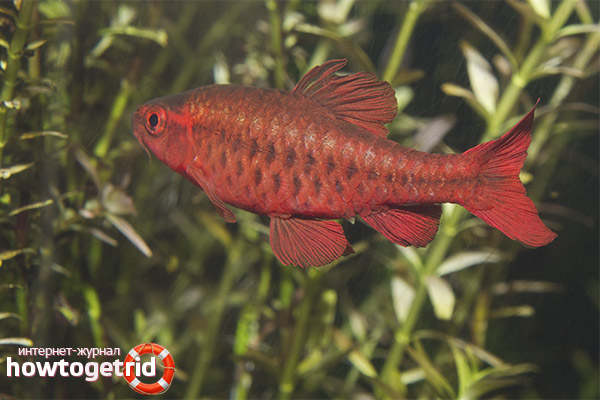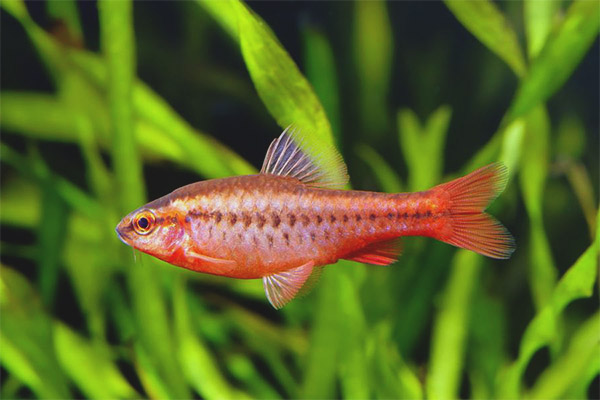The content of the article
Aquarium fish Cherry barb in Latin is called Barbus titteya. It is small in size and very beautiful in appearance. This type is one of the most popular barbs. Fish have a dark red color, for which they got their name. During spawning, the representatives of this species are especially beautiful, since the coloring of the males becomes even much brighter and more expressive. Individuals living in the wild have a brighter and more beautiful color than those found in domestic aquariums. This is due to the fact that in nature, fish feed better in quality, are in their natural habitat. In addition, they have a very low probability of intragenital crossing, which cannot be said about the aquarium breeding of barbs.
Such a fish can easily make any aquarist. Regardless of experience.Cherry barbs do not show aggression to their neighbors in the aquarium, so you can keep them with many species. In the care of these fish unpretentious, and breed them easy.
Like other types of barbs, representatives of this species are very active and lively. In the general aquarium, these red fish look very beautiful, complementing the look with their beautiful coloring. It is desirable that in one aquarium there were several such fish that can gather in a flock. Representatives of similar size can become their neighbors. It is desirable that they were the same active.
Representatives of the species barbus cherry have a somewhat timid nature, so they love to swim in the shade of aquatic plants. When arranging an aquarium, this should be taken into account and provide several places for shelter for them.
Habitat in nature
The species is listed in the Red Book, as it requires observation.This is due to the fact that, since 1988, these barbs were endangered. This kind of crisis lasted about 6 years. But today the situation has improved, so the fish are only being watched.
These beautiful fish live in flat rivers and streams. They like stagnant water or weak currents. The bottom of the reservoirs where these fish live is covered with branches and foliage. Food for them are the larvae and insects.
Description
The body of a cherry barbus has a torpedo shape. Their fins are small, and the tail is bifurcated. The length is less than 5 cm. Usually they live for about 4 years, but if they are well cared for, they can live several years longer.
At rest, this barb has a cherry or brownish color, which in males changes during spawning. At this time, they become brighter, almost scarlet. An intermittent band of dark specks passes along the body.
Content issues

This species belongs to the peaceful fish, which can coexist with almost all non-aggressive species. Care for them is easy. It is only important that the water is clean and that the necessary parameters are maintained.If the aquarist observes these conditions, then there should be no problems in keeping these fish.
Feeding
To feed the cherry barb is also easy. It can eat both artificial and live food. The main rule is not to constantly give the same feed, but periodically change it. It is best to give these fish a little food several times a day. A portion should be such that the fish ate it in a few minutes. If you feed them regularly and with different feeds, the fish will remain active and bright.
When choosing food, it is important to remember that the bar's mouth is small. Therefore, the size of the feed must match. Favorite live food of these small fishes - the tubule and the bloodworm.
Content
Cherry barbs are very active, they move almost constantly. Ideal for them would be a large aquarium, which will be equipped with several places for shelter. Since the fish have a small size, then for a flock consisting of 10 individuals, it is possible to equip an aquarium with a volume of 50 liters or more. It is important that water is constantly replaced and well filtered. In addition, filtering creates a current that reminds these fish of their favorite habitat. Such a course will stimulate them to activity.
In nature, cherry barbs live in flocks, which means that in the aquarium they need to be kept at least 7-10 individuals. If they live in the aquarium less than 5, then this will affect their well-being. They will experience stress, the color will become paler. In addition, life expectancy will be reduced.
In order for the fish to feel comfortable, it is necessary that there are more plants in the aquarium. To create a habitat that will remind the barbs of their natural habitat, you need to build a dark soil and provide an abundance of living plants.
In order for the barbs to stay healthy and bright, you need to maintain the following water parameters: pH level - 6.4-7, temperature - 25-26 degrees.
Compatibility

The cherry barbus is a peaceful fish in nature. This distinguishes this species from many others. They can be contained even with small fish with a veil fins. Barbus cherry live with many. But the neighbors should be fish of about the same size. These small fish can easily become prey for predators. Therefore, it is impossible to settle them together in any case.
Good neighbors for them will be tetras, rasbory. But the angelfish as neighbors will not suit them.They are too big and show aggression.
Sex differences
Young cherry barbs is difficult to distinguish. The sex of adults can be determined. The male of the cherry barb is brighter and slimmer, the female is somewhat larger and has a rounded belly. Males compete with each other in a peculiar way. They do not fight, but demonstrate their bright color.
Breeding
At the bottom of the need to put a grid that protects the eggs from adults. Lighting should be muted. Instead of the grid is allowed to use Javanese moss.
The best temperature for spawning barb is 26 degrees. The pH level is neutral or slightly acidic. To keep the water mixed and provide a small flow, put an aerator or filter. When spawning is equipped, one pair or several individuals are deposited in order to have more males. Before that, they should be given live food.
Spawning will begin at dawn.After this, the individuals are immediately deposited so that they do not eat caviar. A day or two the larvae hatch. And a day later the fry will already swim. In the first days they need to be given an infusoria, and then naupiliyu and microworm.
Video: how to spawn a cherry bar











To send